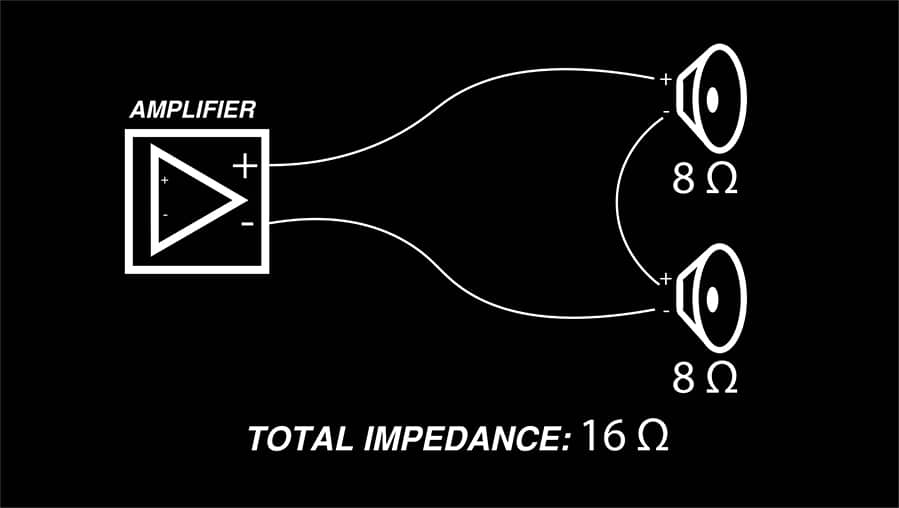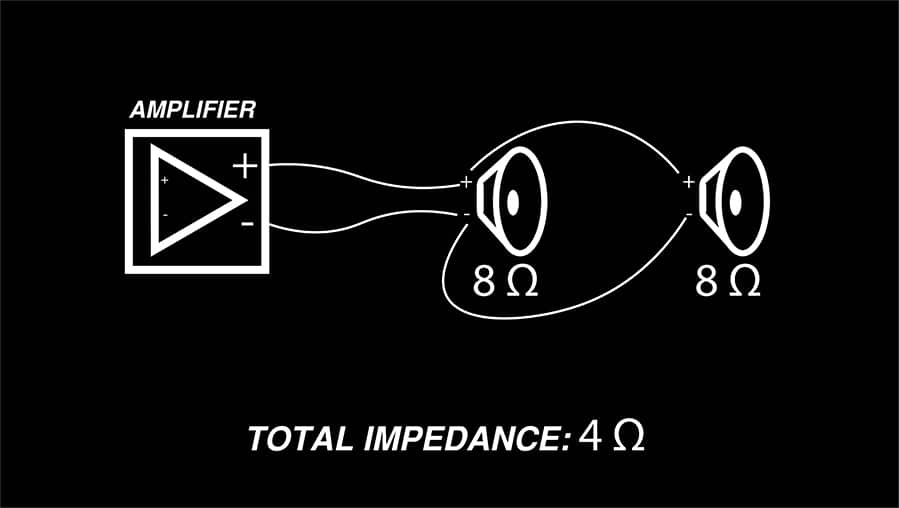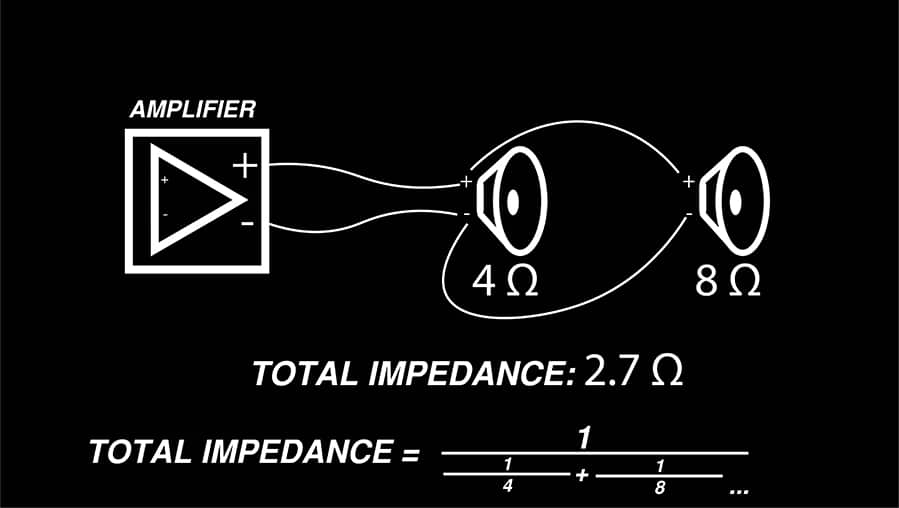In this post, you’ll learn about speaker impedance when connecting multiple speakers to a single amplifier channel. I’ll briefly explain what impedance is. Then, I’ll help you find the impedance specifications for your amplifier and speakers.
By the end of this post, you’ll understand how to calculate total impedance when connecting multiple speakers to a single amplifier channel. But if you want a shortcut, use this Speaker Impedance Calculator:
If you are designing a sound system and want a FREE guide to the most important speaker specifications, download the FREE Loudspeaker Technical Specifications Guide.
I’ve got two Audio University posts that might help if you’re designing a sound system… I’d recommend checking them out here:
What Is Speaker Impedance?
For the purposes of understanding speaker impedance in this post, you can think of impedance as the property of a speaker that resists (or impedes) the flow of energy from an amplifier.
Impedance describes the effective resistance of a circuit to alternating current. It’s a result of both ohmic resistance and reactance, but for most of us there’s no need to get too technical when dealing with speaker impedance.
In this post, you’ll learn what you need to know about speaker impedance in order to design and optimize a sound system. I’ll show you why speaker impedance is important, how to calculate impedance for series and parallel speaker circuits, and I’ll help you choose the best amplifier and speaker combination for your sound system.
Why Is Speaker Impedance Important?
Understanding the impedance of a speaker circuit is very important when designing a sound system. It will not only help to optimize the performance of the system, but will also help to prevent damage to your amp and speakers.
Ohm’s law tells us that as impedance decreases at a given voltage, the electric current will increase.
Your amplifier is only capable of supplying a finite level of current before blowing a fuse, entering protect mode, or being damaged. That’s the main reason it’s so important to ensure that (for a given power output) the impedance of the speaker circuit falls within the impedance rating of your amplifier.
For example, this amplifier is specified to provide 400 watts of continuous power at 8 ohms or 600 watts at 4 ohms.

So long as you abide by these guidelines, you shouldn’t have any issues. But if you attempt to power a 2 ohm speaker circuit, that might cause some problems because the current required to provide adequate power to that circuit may exceed the amplifier’s capabilities.
Powering a speaker circuit that’s impedance is lower than the amplifier’s rating could cause the amp to overheat and shut off. That’s because the amplifier’s power supply and its components are limited in how much current and heat they can withstand.
Many amplifiers have protective circuits in place to prevent damage, but not all of them. So, it’s best to plan ahead and design a system within the manufacturer’s recommendations.
Amplifier & Speaker Impedance Specifications
It’s important to consider the impedance specifications for both your amplifier and your speakers.
Each speaker will have a nominal impedance rating, either on the back of the speaker or in the technical specifications online. A speaker’s nominal impedance is usually 2, 4, 8, or 16 ohms.
Written on the back panel of the amplifier or in its technical specifications, you’ll find the impedance rating of your amplifier. The impedance rating of an amplifier usually ranges between 2 ohms and 16 ohms.
The following sections will help you to ensure that the load presented by your speaker or your speakers falls within the range of your amplifier’s impedance rating.
How To Calculate Speaker Impedance
You can find calculators online that will help to quickly determine the load presented by your speakers based on the impedance of each speaker in the circuit. You can find a useful speaker impedance calculator here. It is, however, still beneficial to learn the formulas for determining impedance so that you get a better understanding of how impedance works.
The impedance of a speaker is frequency dependent, meaning that the impedance at 200 Hz isn’t necessarily the same as the impedance at 2kHz.
To make things simple, speaker manufacturers list a nominal impedance in the specifications. Finding your speaker’s nominal impedance is simple. Just search for the specifications on the manufacturer’s website.
There are three basic scenarios when connecting speakers to an amplifier. The calculation will depend on the scenario.
Impedance With A Single Speaker
The first scenario is a single speaker per amp channel. When you’re only connecting one speaker to an amplifier, no calculations are necessary.
A single 8 ohm speaker presents an 8 ohm impedance to the amp.
As long as 8 ohms falls within the range specified by your amplifier’s specifications, your system should work without any problems.
Remember, some amplifiers have multiple channels. Those channels should be thought of as independent for the purposes of this discussion.

Impedance with Multiple Speakers in Series
The second scenario is connecting multiple speakers to a single amp channel in series. That means the speakers are daisy chained.
When speakers are connected in series, their total impedance can be found by simply adding the nominal impedance of each speaker together.
Two 8 ohm speakers in series present a 16 ohm load to the amplifier.

Connecting a 4 ohm speaker and an 8 ohm speaker in series will present a 12 ohm load to the amplifier.

How to Connect Speakers in Series
To connect speakers in series, wire the positive terminal of the amplifier to the positive terminal of the first speaker. Then, wire the negative terminal of each speaker to the positive terminal of the next speaker. The negative terminal of the last speaker will connect to the negative terminal of the amplifier, completing the series circuit.
Impedance with Multiple Speakers in Parallel
The third scenario is multiple speakers connected in parallel.
If all of the speakers have the same impedance, you simply take that impedance rating divided by the number of speakers being connected.
For example, connecting two 8 ohm speakers in parallel will present a 4 ohm load to the amplifier. That’s calculated by dividing eight ohms by two speakers.

If the speakers in the parallel circuit do not all have the same impedance rating, you’ll need to use a different formula.

To calculate the total impedance of a 4 ohm speaker and an 8 ohm speaker connected in parallel, I’ll plug the numbers into the formula like this, which gives us a total impedance of about 2.7 ohms. This would be too low for most amplifiers to operate at without overheating.

How to Connect Speakers in Parallel
To connect speakers in parallel, wire the positive terminal of the amplifier to the positive terminal on each speaker. Then, wire the negative terminal of the amplifier to the negative terminal on each speaker.
Now that you understand why speaker impedance is important, I’d recommend checking out one of these posts to find the right speaker and amplifier combination for your system:
I also wrote these guides on speaker polarity (positive vs negative) and speaker crossovers. Check them out to make sure you are connecting your speakers correctly for optimal performance!
If you are designing a sound system and want a free guide to the most important speaker specifications, download the FREE Loudspeaker Technical Specifications Guide.
The Loudspeaker Technical Specifications Guide is a downloadable PDF file. Just let me know where you want me to send it.
” _builder_version=”4.7.4″ _module_preset=”default”][/et_pb_signup][/et_pb_column][et_pb_column type=”1_2″ _builder_version=”4.7.4″ _module_preset=”default”][et_pb_image src=”https://audiouniversityonline.com/wp-content/uploads/2020/12/Loudspeaker-Technical-Specifications-Guide-Cover-2.jpg” title_text=”Loudspeaker Technical Specifications Guide – Cover 2″ align=”center” _builder_version=”4.7.4″ _module_preset=”default” max_width=”480px” custom_margin=”0px||16px||false|false” custom_margin_tablet=”” custom_margin_phone=”0px||||false|false” custom_margin_last_edited=”on|phone” box_shadow_style=”preset3″ box_shadow_vertical=”40px” box_shadow_blur=”80px” box_shadow_spread=”-20px” box_shadow_color=”rgba(0,0,0,0.8)”][/et_pb_image][/et_pb_column][/et_pb_row][/et_pb_section]